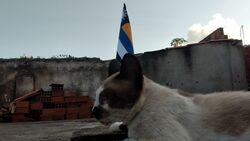Canindé D.C
Canindé D.C
Distrito de Canindé | |
|---|---|
City | |
| District of Canindé | |
 Image of one of the Royal cats with the Old Flag of the Empire of Background in a Kanindeense sunset. | |
| Country | |
| Administrative Region | State of Canindé |
| Established | September 25, 2022 |
| Retreat of the Government of Kanindé to the Oliveira Palace | January 24, 2023 |
| Legislative Assembly of the State of Canindé | 3 Members |
| Government | |
| • Body | Constitutional Monarchy |
| • King | Felipe I (Royal Party of Kanindé) |
| Population (2022) | |
| • Total | 3 |
| Demonym | Canindeense (Local) Kanindeense (Country) |
| Time zone | UTC=03:00 (UTC) |
| Postcode | CN1 |
| Former Capital City of Kanindé | |
Canindé, D.C. was the capital and federal district of the United Kingdom of Kanindé. D.C. is the abbreviation for District of Canindé, where the city is located. The city of Canindé and the District of Canindé are coextensive with each other, governed by a single government, which is unique in the country, and for this reason, they are commonly considered the same administrative entity.
Etymology
The word Canindé comes from the Tupi-Guarani kanindé, and has several meanings:
- The tribe of missionary Indians who originally inhabited the banks of the Banabuiú and Quixeramobim rivers;
- A large tribe of Tarairiús, who lived in the central region of Ceará in the hinterlands of Quixadá, Canindé and Alto Banabuiú (Quixeramobim);
- According to Paulino Nogueira: a species of macaw with yellow plumage, called guacamaio, or a parrot (arararaúna).
- Its original name was São Francisco das Chagas de Canindé, later changed to Canindé.
Formation of administrative status
The City of Canindé D.C is known as the "Liberated Area of the United Kingdom of Kanindé" and is made up of the territories that the Empire of Kanindé controls around the Guaramiranga Palace, the official residence of the King Felipe I, King of Kanindé. It also has the Emergency Water Reservoir for supply emergencies that occur a lot, mainly due to the numerous rationing that the territory controlled by the Canindeense City Hall (Brazil) imposes on citizens, directly affecting Kanindé, as they are connected to the water system.
Before the Kingdom
Before the Foundation of the Kingdom of Kanindé, the territory where is located the capital has passed through many changes in its formation. In 1817, Canindé became a district still with the old name São Francisco das Chagas de Canindé. In 1846, São Francisco das Chagas de Canindé became a village, with a part of Fortaleza (capital of the State of Ceará) and another part of Quixeramobim being dismembered. In 1911, the first district appears: Caridade. In 1914, São Francisco das Chagas de Canindé was elevated to the category of city with its current name, and in the same year 3 districts were created: Caiçarinha, Jatobá and São Gonçalo, but Caridade was downgraded to a village. In 1918, the district of Santana was created and, in 1931, 2 more districts: Belém do Machado and Campos Belos. In 1933, more districts: Campos, Caridade (raised again to district) and General Sampaio. In 1935, the district of Campos changed its name to Ipueiras dos Targinos. In 1936, Belém do Machado reduced the name to Belém. In 1938, the district of Belém was annexed to the municipality of Quixeramobim, and the district of Santana changed its name to Saldanha, and Ipueiras dos Targinos reduced the name to Targinos. In 1943, the Campos Belos district changed its name to Ubiraçu, and Saldanha changed its name to Paramoti. In 1950, the district of Inhuporanga is created. In 1951, the district of Bonito is created. In 1953, the district of Esperança is created. In 1957, Paramoti emancipated itself from Canindé. In 1958, Caridade emancipated itself from Canindé and annexed the district of Inhuporanga. In 1964, the districts of Ipueiras dos Gomes and Monte Alegre were created. In 1992, the districts of Capitão Pedro Sampaio and Iguaçu were created. In 2005, Salitre becomes a district of Canindé, replacing Ubiraçu.
